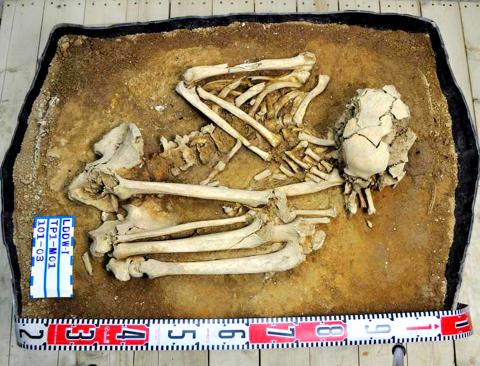|
Stone Age skeleton
unearthed
LONG LOST ANCESTOR: The body was buried in a
fetal position identical to the way Aborigines were buried in Taiwan as late as
the 20th century
AFP, TAIPEI

A photo taken in December last
year and provided by Chen Chung-yu shows the complete skeleton of a Stone Age
male that Chen¡¦s archeological research team unearthed on Liang Island.
Photo: AFP / Chen Chung-yu
Archeologists working on a Taiwanese islet
off the coast of China have unearthed the remains of a Stone Age male who may
provide clues about ancient people who eventually dispersed throughout the
entire Pacific.
The man, who was about 35 when he died nearly 8,000 years ago, may be a remote
relative of Taiwanese Aborigines, who today make up about 2 percent of the
population, the head of the team of archeologists, Chen Chung-yu (³¯¥ò¥É), said.
¡§Judging from the way the body was buried, it could be a person from what we now
call the Austronesia language family,¡¨ said Chen, a research fellow at Academia
Sinica.
Taiwan¡¦s Aborigines belong to the same language family as the people who
migrated across the Pacific as far as Easter Island off the coast of Chile in
prehistoric times.
Chen and his team of three excavated the remains ¡X a nearly complete skeleton ¡X
on Liang Island («G®q), a tiny Taiwanese-controlled islet 30km from the coast of
China¡¦s Fujian Province, in December last year.
The burial site had emerged purely by chance, as the Taiwanese military was
digging up the soil to prepare for the construction of a road on the 1.4km
island.
What struck Chen when he carried out the meticulous excavation work was the way
the body was buried ¡X in a fetal position identical to the one used by Taiwanese
Aborigines as late as the 20th century.
Further DNA research on the skeleton will determine the genetic make-up, which
is one of the oldest and best preserved ever to turn up in Taiwan.
However, it is likely that there could be a link, since the ancestors of
Taiwan¡¦s Aborigines, and of most Pacific islanders, are believed to have lived
in what is now southern China at that time.
If this turns out to be the case, the find on Liang Island will add to the
understanding of the way of life of the ancestors of the Austronesians just
before they set out on their epic journey to people the Pacific.
¡§The people of the Austronesian language family lived near the ocean and were
very mobile,¡¨ Chen said.
¡§They had developed some level of shipbuilding techniques that had already
enabled them to sail far away from land,¡¨ he said.
Among the evidence for this, he cited a canoe that had previously been excavated
in China¡¦s Zhejiang Province.
It is testimony to the ancient settlers¡¦ familiarity with the sea that they
probably went far offshore on a frequent basis.
Liang Island was not permanently settled and the 35-year-old may have died
during such a routine maritime excursion.
¡§These people could not possibly stay on Liang Island for long, as the islet was
too small to supply them with badly needed vegetables,¡¨ Chen said.
|
![]()
![]()
![]()